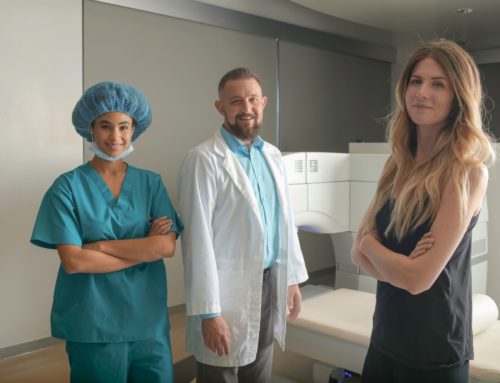Cataract surgery is a quick, and painless type of eye surgery that is used to treat cataracts by replacing your eye’s natural lens with an artificial lens called an intraocular lens. Cataracts are a common age-related condition that can cause blurred vision, sensitivity to light, and difficulty seeing in low-light conditions. Under normal circumstances, light that hits your natural lens is focused by it, converting it into signals, which your brain interprets as images. In an individual with cataracts, dense, cloudy areas made up of clumping proteins, prevents your eye’s natural lens from focusing the light, resulting in vision loss. In the United States, approximately 4 million cataract surgeries are performed annually as of 2021 [1], making it one of the most frequently performed procedures.
Who Performs Cataract Surgery?
Cataract surgery is typically performed by an ophthalmologist, a medical doctor who specializes in the diagnosis and treatment of eye diseases. Cataract surgery can also be performed by an ophthalmic surgeon, a surgical doctor who specializes in the care of the eyes.
What Is An Intraocular Lens?
An intraocular lens (IOL) is a clear, flexible lens that is inserted into your eye during cataract surgery. The IOL replaces the cloudy natural lens by being rolled into place through a small incision that is made during the procedure. IOLs are made of a variety of materials, including acrylic, silicone, and polycarbonate. The lens type you get during your cataract surgery is dependent on what type of vision you need, and whether you have astigmatism.
What Are The Different Types of Cataract Surgery?
There are three types of manual cataract surgery: manual small incision cataract surgery (MSICS), manual extracapsular cataract extraction (ECCE), and phacoemulsification, as well as, one type of laser-assisted cataract surgery called: femtosecond laser-assisted cataract surgery (FLACS).
- Manual Small Incision Cataract Surgery (MSICS) is a variation on the MECS technique, that is performed using a very small v-shaped incision. This incision is about 6-7-millimeters on the outside edge, and <11-millimeters on the inner edge. This type of surgery is often used for people who have a smaller cataract or who are at high risk for complications.
- Extracapsular Cataract Extraction (ECCE) this type of cataract surgery is performed by making a 9-13-millimeter long incision from which the natural lens is removed, and the artificial replaced. Unfortunately, this type of cataract surgery does require sutures.
- Phacoemulsification is performed by using a high-frequency ultrasound to break up the cloudy natural lens into tiny pieces so that they can be easily removed from the eye using a suction tool. With this type of cataract surgery, a 2-3-millimeter long incision is made, and it does not require sutures.
- Femtosecond Laser-assisted Cataract Surgery (FLACS) is performed by using a high-power femtosecond laser to create a cornea flap, from which the cloudy, natural lens is divided and softened up using ultrasonic vibrations. The cataract is then removed, the IOL is inserted, and the flap is replaced.
What Happens During Cataract Surgery?
The exact procedure steps may vary depending on which cataract surgery treatment you are receiving. In general, you can expect the following:
- You will be asked to not eat or drink anything before the surgery. You may also be required to stop taking certain kinds of medications for a few days prior as well.
- Your surgeon will dilate your pupils and numb your eye with anesthetic eye drops. You may be given a sedative to help you relax, but you will remain awake during the surgery.
- The clouded lens will then be removed, either using an ultrasound probe to break up the lens via phacoemulsification, or the lens will be removed in one piece by making an incision in the eye.
- Once the clouded lens is removed via one of the cataract surgical methods listed above, an IOL or intraocular lens will be inserted into the eye and positioned where your original lens was located. The IOL is flexible and foldable, and as such, stitches are typically not required to close up any incisions made.
- You will rest in the recovery area for up to 30-minutes, and then you’ll be able to go home.
How Long Does Cataract Surgery Last For?
Cataract surgery typically lasts for about 30 minutes. However, the time it takes to complete the surgery may vary depending on the type of cataract surgery you have and your individual circumstances.
What Happens After Cataract Surgery?
After your cataract surgery, you will be asked to remain for up to 30-minutes as the doctors will want to assess how the surgery went, and run you through the instructions on after-care. An eye shield will be used to cover up your eye, and you will be given special eye drops to use for the next 4-6 weeks to help reduce any risk of infection.
It is normal to experience some blurriness and light sensitivity following the surgery. This will improve over time as your eye begins to heal, and your vision begins to come back. Most individuals can resume their normal activities within a few days, up to a few weeks later, depending on how quickly the healing process goes. It is very important to follow the after-care instructions given to you, as these will ensure a smooth and quick recovery.
How Does Cataract Surgery Work If I Need Both Eyes Done?
If you need cataract surgery in both eyes, two surgeries will be scheduled for you. These procedures will take place two to six weeks apart from one another, and you’ll be given eye drops to use in between surgeries. The surgeries are scheduled like this so that your vision returns to the first eye during the healing process, before you undergo surgery for the second eye.
When Is It Time to Book a Cataract Surgery Consultation? Symptoms to Watch Out For
Cataract surgery is recommended for individuals when a cataract makes it difficult for you to carry out your daily activities, or if it is preventing your eye doctor from being able to treat other eye problems. While you won’t notice any changes to your vision in the early stages of cataract development, there are some signs that you should look out for:
- Blurred vision.
- Difficulty seeing in low-light conditions like at night.
- Sensitivity to light – seeing glares and halos.
- Fading colors.
- Double vision.
If you experience any of these symptoms, it is best to book a consultation with an eye surgeon right away, to see if it is time for cataract surgery.
Is Cataract Surgery Safe?
Yes, cataract surgery is considered to be a safe and low-risk surgery, with the majority of individuals undergoing the procedure with zero complications. Like all surgical procedures, there is a very low chance of complications or risks, some of which include: infection, bleeding, retinal detachment, glaucoma, and cataract re-growth.
How Soon Can I Expect To See Better Vision After Cataract Surgery?
The majority of people will see an improvement in their vision within a few days after surgery. Since cataracts are often yellow-tinted, you can expect colors to be more vibrant after surgery, as you’ll be looking through a clear lens. It is important to note though, that it may take several weeks for your vision to fully stabilize. It is normal for your eye to be mild discomfort, and for you to experience itchiness – avoid rubbing or pushing on the eye.
Will There Be Follow-up Appointments?
Yes, you will have a follow-up appointment with your provider. If you experience any pain or redness that worsens even with medication, stickiness around the eye, worsening vision, flashes of light, or small dark spots/lines that float across your vision, then seek out medical help.




